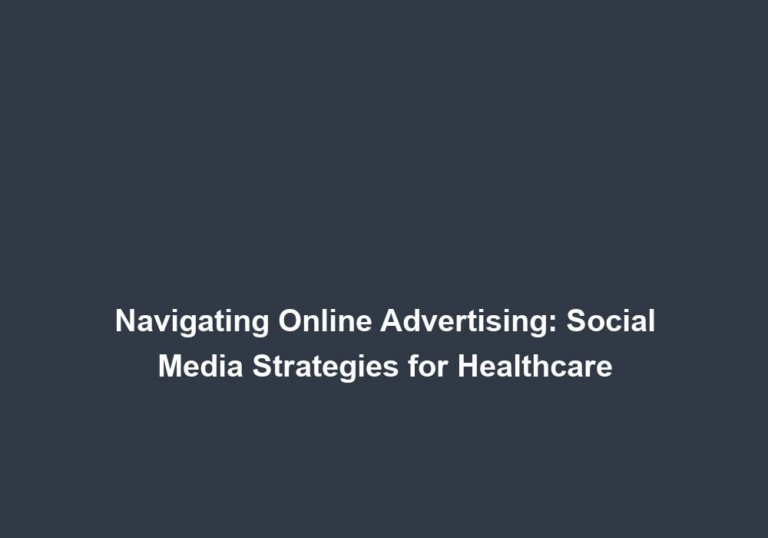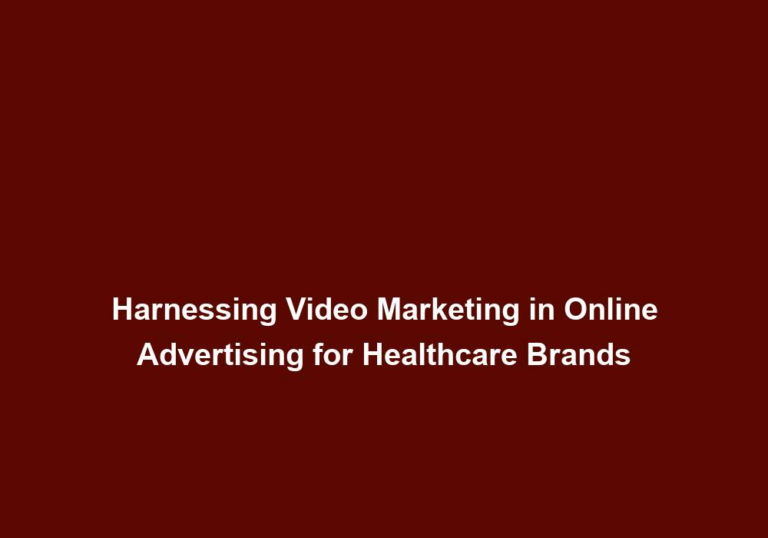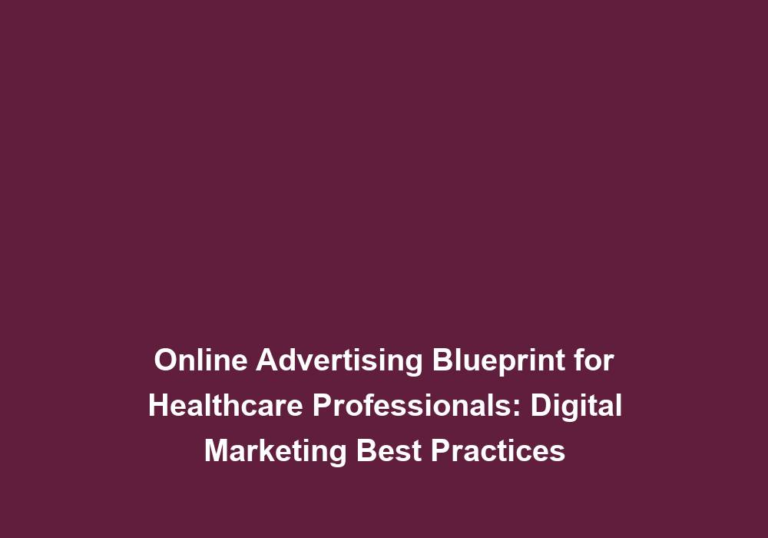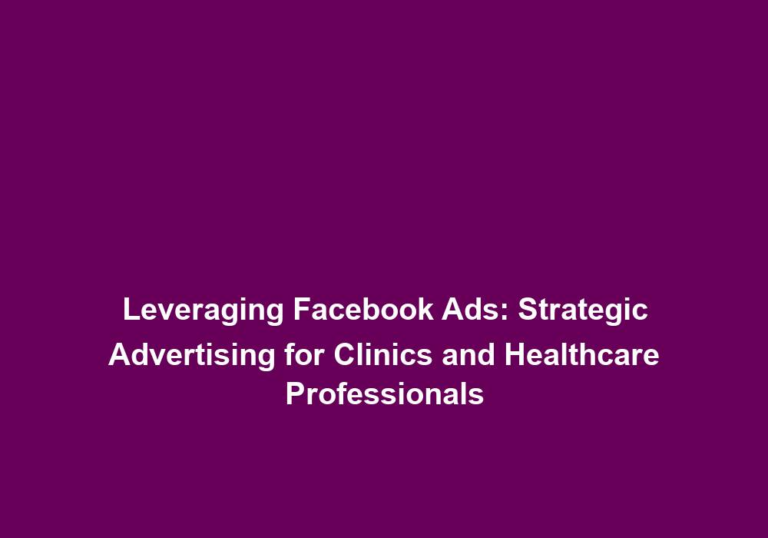Visual Attraction: Mastering Display & Banner Ads for Healthcare Marketing
In today’s digital world, where attention spans are dwindling, visual attraction plays a crucial role in capturing the interest of consumers. When it comes to healthcare marketing, display and banner ads are powerful tools that can effectively convey your message and attract potential patients. In this article, we will explore the key strategies and best practices for mastering display and banner ads in the healthcare industry.
Understanding the Importance of Visual Appeal
Visual appeal is vital in healthcare marketing as it helps to create an immediate connection with your target audience. When consumers see visually appealing ads, they are more likely to engage with the content and remember your brand. This is especially important in healthcare, where trust and credibility are paramount.
To enhance visual appeal, consider the following:
-
Use captivating imagery that resonates with your target audience. For healthcare marketing, striking a balance between relatability and professionalism is essential. Utilize images that evoke positive emotions and showcase real patients or healthcare professionals. Avoid stock photos that appear overly staged or generic.
-
Incorporate color psychology to influence emotions and behavior. Choose colors that align with your brand identity and evoke the desired response from your target audience. For example, blue conveys trust and reliability, while green symbolizes health and wellness. Use colors strategically to create visually appealing and emotionally engaging ads.
-
Maintain brand consistency across all marketing channels. Establishing brand recognition and trust is crucial, so ensure your display and banner ads align with your overall brand identity. This includes using consistent colors, fonts, and imagery. Brand consistency reinforces your message and differentiates you from competitors.
Designing Eye-Catching Display and Banner Ads
Creating eye-catching display and banner ads involves several key factors that contribute to their overall effectiveness. Let’s explore each one in detail:
1. Compelling Copywriting
An impactful display or banner ad starts with compelling copywriting. Craft a concise and persuasive headline that immediately grabs attention and communicates your unique selling proposition. Use clear and concise language, avoiding medical jargon that may confuse or alienate your audience.
In addition, consider the following tips:
-
Address the pain points and concerns of your target audience in your copy. Highlight the benefits and unique selling points of your healthcare services to emphasize why they should choose you.
-
Use a conversational tone to establish a connection with your audience. Make your copy relatable and easy to understand, avoiding complex medical terminology.
-
Incorporate keywords relevant to your healthcare services to optimize your display and banner ads for search engines. This can improve your visibility and attract organic traffic.
2. High-Quality Imagery
Choose high-quality imagery that not only captures attention but also resonates with your target audience. For healthcare marketing, it is essential to strike a balance between relatability and professionalism. Use images that evoke positive emotions and showcase real patients or healthcare professionals. Avoid stock photos that appear overly staged or generic.
To further enhance the impact of your imagery, consider these suggestions:
-
Incorporate images that reflect the diversity of your target audience. This will help them feel represented and increase their connection with your brand.
-
Show real-life scenarios and situations that your target audience can relate to. This will make your ads more relatable and increase engagement.
-
Use images that reflect the desired outcome or benefits of your healthcare services. For example, if you offer weight loss programs, include images of individuals who have achieved their weight loss goals.
3. Color Psychology
Color psychology plays a significant role in influencing emotions and behavior. Select colors that align with your brand identity and evoke the desired response from your target audience. For instance, blue conveys trust and reliability, while green symbolizes health and wellness. Use colors strategically to create a visually appealing and emotionally engaging ad.
To effectively utilize color psychology, consider these tips:
-
Use contrasting colors to make key elements, such as your headline or call-to-action, stand out. This will draw attention and increase the likelihood of user engagement.
-
Experiment with different color combinations to see which ones resonate best with your target audience. Conduct A/B testing to determine the most effective color scheme for your display and banner ads.
-
Keep in mind cultural associations with colors. Different cultures may have different interpretations of colors, so consider your target audience’s cultural background when selecting colors.
4. Brand Consistency
Maintaining brand consistency across all marketing channels is crucial for establishing brand recognition and trust. Ensure that your display and banner ads align with your overall brand identity, including the use of consistent colors, fonts, and imagery. This consistency helps to reinforce your brand message and differentiate you from competitors.
To maintain brand consistency, consider the following:
-
Create brand guidelines that outline the specific colors, fonts, and imagery to be used in your display and banner ads. This will ensure consistency across all marketing materials.
-
Use your logo prominently in your ads to increase brand recognition. Make sure it is clear and legible, even at smaller sizes.
-
Incorporate elements from your website or other marketing materials into your display and banner ads. This will create a cohesive brand experience for your audience.
5. Effective Call-to-Action (CTA)
An effective CTA serves as a catalyst for user engagement. Clearly state the desired action you want users to take, such as Schedule an Appointment or Learn More. Position the CTA prominently within the ad, using attention-grabbing buttons and contrasting colors to make it stand out. A compelling CTA can significantly improve the click-through rate of your ads.
To create an effective CTA, consider these recommendations:
-
Use action-oriented language that encourages users to take immediate action. For example, instead of “Click Here,” use “Get Started Now” or “Book Your Appointment Today.”
-
Make your CTA visually distinct from other elements in the ad. Use a contrasting color, larger size, or different font to ensure it stands out.
-
Consider offering incentives or rewards for users who respond to your CTA. This can further motivate them to engage with your healthcare services.
Best Practices for Display and Banner Ads
Now that we have covered the key elements of designing attractive display and banner ads, let’s delve into some best practices for healthcare marketing:
1. Targeted Audience Segmentation
Identify and segment your target audience based on demographics, interests, and behavior. By understanding your audience’s specific needs and preferences, you can tailor your display and banner ads to resonate with them on a deeper level. This targeted approach increases the effectiveness and relevance of your marketing efforts.
To effectively segment your audience, consider the following:
-
Conduct market research to gather insights into the demographics, interests, and behaviors of your target audience. Use this information to create detailed buyer personas.
-
Develop personalized messaging and imagery based on each buyer persona. This will help create a more personalized and engaging experience for your audience.
-
Use audience targeting tools on advertising platforms to reach specific segments of your target audience. This can help optimize your ad spend and improve overall campaign performance.
2. Clear and Concise Messaging
Ensure that your ad conveys a clear and concise message. With limited space available, every word matters. Focus on the key benefits and unique selling points of your healthcare services, addressing the pain points of your target audience. Use simple language that is easy to understand, avoiding complex medical terminology.
To create clear and concise messaging, consider these suggestions:
-
Craft a compelling headline that immediately grabs attention and communicates the value of your healthcare services. Use concise language that clearly conveys your unique selling proposition.
-
Highlight the benefits and outcomes that your target audience can expect from your services. Focus on how your services can solve their problems or improve their lives.
-
Use bullet points or numbered lists to break down complex information into easily digestible chunks. This will make your ad more scannable and increase user engagement.
3. Mobile Optimization
With the majority of internet users accessing content on their mobile devices, it is crucial to optimize your display and banner ads for mobile viewing. Ensure that your ads are responsive and visually appealing on smaller screens. Keep the text and imagery concise and legible, making it easy for users to engage with your content.
To effectively optimize your ads for mobile, consider these recommendations:
-
Test your display and banner ads on various mobile devices and screen sizes to ensure they are visually appealing and functional.
-
Optimize load times by compressing images and minimizing unnecessary elements. Slow load times can lead to higher bounce rates and lower engagement.
-
Make sure your text is large enough to be easily readable on smaller screens. Avoid long paragraphs and use bullet points or short sentences to convey information.
4. A/B Testing
To maximize the effectiveness of your display and banner ads, conduct A/B testing. Test different variations of your ads by changing elements such as headlines, imagery, colors, or CTAs. Analyze the performance metrics to determine which version resonates best with your target audience. Continuously optimize your ads based on the insights gained from testing.
To conduct effective A/B testing, consider the following:
-
Begin by identifying the specific elements you want to test, such as headlines, imagery, colors, or CTAs. Make sure to change only one element at a time to accurately measure its impact.
-
Split your target audience into two groups and show each group a different version of the ad. Monitor the performance metrics, such as click-through rate and conversion rate, to determine the winning variation.
-
Iterate and optimize based on the insights gained from A/B testing. Use the data to inform future ad designs and improve overall campaign performance.
5. Tracking and Analytics
Implement tracking and analytics tools to measure the performance of your display and banner ads. Monitor key metrics such as click-through rate, conversion rate, and return on investment. This data-driven approach allows you to make informed decisions and refine your healthcare marketing strategies for better results.
To effectively track and analyze your ad performance, consider these suggestions:
-
Set up conversion tracking to measure the specific actions users take after engaging with your ads. This can include form submissions, appointment bookings, or purchases.
-
Use analytics tools to gain insights into user behavior on your website or landing page. This can help you understand how users interact with your ads and identify areas for improvement.
-
Regularly review and analyze your ad performance metrics to identify trends and patterns. Use this information to optimize your campaigns and allocate resources effectively.
Conclusion
Mastering display and banner ads in healthcare marketing requires a combination of compelling copywriting, high-quality imagery, and strategic design choices. By understanding the importance of visual attraction and implementing best practices, you can create captivating ads that effectively engage your target audience. Remember to stay consistent with your brand identity and continuously optimize your campaigns based on data-driven insights. Embrace the power of visual appeal and watch your healthcare marketing efforts thrive.







